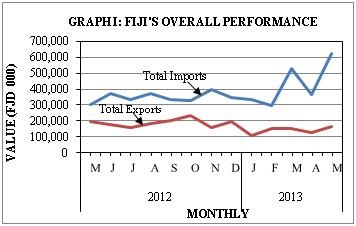The positive news is that the Fijian economy seems to have made a sustained recovery since 2011, after the impact of the economic fallout from the December 2006 coup.
However, the recovery may not be as much as what is being forecast by Reserve Bank of Fiji. The annual growth rate of GDP is forecast to grow by 3.2% this year, after recording an average annual growth rate of just 0.5% for the period 2007-2012.
This period includes two bouts of contractions in output in 2007 and 2009, equal to 0.9% and 1.3% respectively.
Major factors
While some of the contributing factors to this period of negative and low growth episode could also be attributed to the spike in food and fuel prices in 2008 and the global economic crisis in 2009, the major contributor has been the static as well as the dynamic consequences of the 2006 coup.
Therefore, it is too early to rejoice over the last three years of modest recovery as much more in terms of structural reforms, policy-reorientation and restoration of macroeconomic confidence in the economy will be needed to sustain the economic recovery and move beyond 3% growth rate in the economy.
Job losses
The immediate economic effect of the 2006 coup was reminiscent of a political instability and a crisis of confidence. Two months after the coup, the Reserve Bank of Fiji noted that around 3000 jobs had been lost, mainly due to the decline in the tourism industry and the closure of the gold mine.
At the same time, a Fiji Employers Federation Survey showed an increase in redundancies, reduced hours of work and temporary unemployment.
The signs of tough economic times ahead were evident and the challenge for the interim regime in 2007 was to devise strategies to achieve a quick economic recovery and increase the level of investor confidence in the economy.

Incoherent strategy
Despite the macroeconomic policies and reforms post 2006, the interim regime lacked a consistent political strategy towards democracy which has acted as a continued source of drag on the level of confidence in the economy.
Boosting confidence towards achieving higher growth rates has mostly remained elusive. Biman Chand Prasad argued in 2010 that the basic cause of sluggish economic recovery and low growth from 2007 to 2009 was mainly tied to the perceived political instability and uncertainty about future economic policies.
The economy has now been estimated to have grown by 2.2% in 2012, slightly lower than the earlier forecast of 2.5%. Growth forecast for 2013 has now been optimistically revised from 2.7% announced in the 2013 National Budget.
The key impetus towards the upward revision is stated as higher levels of private sector and public sector (including statutory corporations) investment which is estimated to reach 28% of GDP in 2013 (Reserve Bank of Fiji, 2013).
With this, the short term outlook for Fiji is positive, but given the small size of the economy, the precise shape of the forecast will be subject on the timing with which on-going and planned investment projects come on stream.
Dr Neelesh Gounder teaches at the School of Economics, University of the South Pacific in Suva, Fiji. The above is an extract of a Paper presented by him along with his colleague Dr Biman Chand Prasad at a Conference held at Holiday Inn, Suva on August 20, 2013. Another related report appears in this Section. We will publish other extracts of their Paper in ensuing editions






